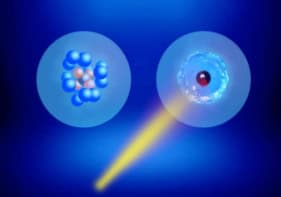A stable compound of the noble gas argon has been created for the first time. Noble gases have full outer shells of electrons and are therefore very unreactive. Leonid Khriachtchev and colleagues at the University of Helsinki in Finland believe their discovery brings us quite close to understanding the formation of chemical bonds of the rare gases (2000 Nature 406 874). There are now only two remaining elements, the inert gases helium and neon, without known compounds.
Argon is the lightest yet of the inert gases to have formed a compound. It is difficult to persuade light inert gases to react because their outer electrons are shielded less from the electrostatic pull of the nucleus by the inner electrons that are present in heavier noble gases. Khriachtchev and co-workers created the new compound argon fluorohydride – or HArF – by photolysis of hydrogen fluoride in an inert argon matrix at 7.5 kelvin. The matrix separates the HArF molecules, which would break up into more stable argon and hydrogen fluoride molecules if they collided with each other. Heating above about 27 kelvin also causes the molecules to decompose. ‘The first Ar molecule will have no practical applications because it is too reactive’, Markku Rasanen, a colleague of Khriachtchev, told PhysicsWeb, ‘but its bonding puts us on the right track for making further Ar compounds which may have applications’.
The team believes that a similar process might yield equivalent compounds of the remaining light inert gases, helium and neon. Although early attempts have been unsuccessful, the discovery of the new compound may spur other researchers into action.



